ineffective.
Figure 5-12. M1012
18 April 2005
FM 3-19.15
5-7
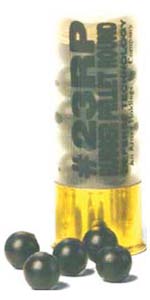
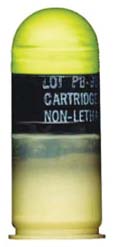
Nonlethal Capabilities Set and Employment Considerations
12-GAUGE, CROWD DISPERSAL, NONLETHAL CARTRIDGE (M1013)
5-15. The M1013 (see Figure 5-13) is a multiple projectile round with .23
caliber hard rubber pellets that is designed to be fired at and employed with
the purpose of affecting multiple targets. With a muzzle velocity of 900 feet
per second, the M1013 has an effective range of no closer than 5 meters and no further than 30 meters. Engagement inside 5 meters could cause serious
injury or death. Beyond 30 meters, the kinetic energy dissipates to the point
where the rubber pellets become ineffective.
Figure 5-13. M1013
40-MILLIMETER SPONGE GRENADE (M1006)
5-16. The M1006 (see Figure 5-14) is a single projectile round made of pliable foam rubber with a hard plastic back. The M1006 is designed to be aimed and
fired at a single target. With a muzzle velocity of 265 feet per second, the
M1006 has an effective range of no closer than 10 meters and no further than
50 meters. Engagements inside 10 meters could cause serious injury or death.
Beyond 50 meters, the kinetic energy dissipates to the point where the round
becomes ineffective.
Figure 5-14. M1006
5-8
FM 3-19.15
18 April 2005
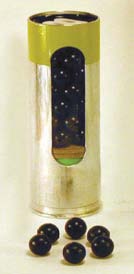
Nonlethal Capabilities Set and Employment Considerations
40-MILLIMETER CROWD DISPERSAL CARTRIDGE
5-17. The crowd dispersal cartridge (CDC) (see Figure 5-15) is a multiple projectile round with .48 caliber hard rubber balls that is designed to be fired and employed with the purpose of affecting multiple targets. With a muzzle
velocity of 450 feet per second, the CDC has an effective range of no closer
than 10 meters and no further than 30 meters. Engagement inside 10 meters
could cause serious injury or death and beyond 30 meters the kinetic energy
dissipates until the rubber balls become ineffective.
Figure 5-15. CDC
RUBBER BALL GRENADE (GG04)
5-18. The GG04 (see Figure 5-16, page 5-10) is a multiple projectile, flash-bang grenade with 100 .25-caliber hard rubber pellets. Each grenade has a
fuse delay of 2.8 to 3 seconds with a flash measuring approximately 1 million
CP and 180 decibels at 3.5 feet. At detonation, rubber pellets are dispatched at 360° with an effective range of 2 to 3 meters and a maximum engagement
range of 15 to 20 meters. The rubber ball grenade is designed to be hand-
thrown or muzzle-launched from a 12-gauge shotgun.
RUBBER BALL GRENADE LAUNCHING CUP AND AA30 12-GAUGE LAUNCH ROUND
5-19. The launch cup (see Figure 5-17, page 5-10) firmly attaches to the 12-gauge shotgun without any additional tools. It works in concert with the AA30
12-gauge launch round to propel the rubber ball grenade approximately 100
meters. The shooter simply inserts the full body and the safety lever of the
grenade into the launching cup, pulls the pin, loads a 12-gauge round, and
fires (approximately) at a 30° angle. The desired effect is to have the grenade explode approximately 7 to 10 feet above the target.
RELOADABLE FLASH-BANG GRENADE (M84)
5-20. The M84 (see Figure 5-18, page 5-10) is a reloadable flash-bang thrown grenade. Each grenade has a 1- to 2-second fuse delay, with a flash capability of 1.5 to 2.5 million CP and a bang of 168 to 175 decibels. Although it is part of 18 April 2005
FM 3-19.15
5-9
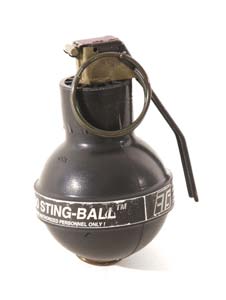
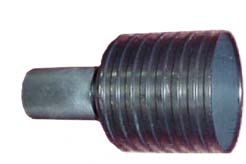


Nonlethal Capabilities Set and Employment Considerations
the NLCS, use of the M84 is not recommended for use in crowd control
situations. Specialty teams, such as security response teams, and search
teams may use this device effectively.
Figure 5-16. GG04
Figure 5-17. Launching Cup and AA30
Figure 5-18. M-84
5-10
FM 3-19.15
18 April 2005

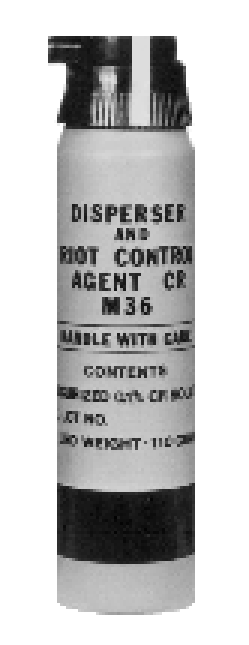
Nonlethal Capabilities Set and Employment Considerations
FLEX-CUFS
5-21. Flex-Cufs consist of a tough pliable plastic band with a self-locking
mechanism in the center for each end. When the Flex-Cuf (see Figure 5-19) is threaded the restraint bands circle around the wrists or ankles, impeding
movement and securing the individual. They are lightweight and disposable
and require a cutting tool or other instrument to remove.
Figure 5-19. Flex-Cufs
INDIVIDUAL RIOT CONTROL AGENT DISPERSER (M36)
5-22. The M36 (see Figure 5-20) contains a Dibenz (F, -1 4-oxazepine [CR]
solution. It can deliver 25 one-second bursts out to 12 feet. Individual
disposable RCA dispersers are intended primarily for self-defense or to keep
rioters out of arm’s reach of soldiers conducting crowd control formations or
soldiers engaged in missions where a noncombatant exists.
Figure 5-20. M36
MIDSIZE RIOT CONTROL AGENT DISPERSER (M37)
5-23. The M37 (see Figure 5-21, page 5-12) is the size of a standard fire extinguisher that uses compressed air to force the RCA out to a range of 30
feet. It has the capacity to employ 18 bursts for 3 seconds per charge. It is
excellent for providing a wide coverage of RCAs onto a hostile crowd while
18 April 2005
FM 3-19.15
5-11


Nonlethal Capabilities Set and Employment Considerations
maintaining excellent standoff capability. The M37 can be refilled and is
rechargeable. It can be filled with CR solution (liquid agent) or CS1 (dry
agent). For training purposes, CR can be substituted with water and CS1 can
be substituted with talcum powder.
Figure 5-21. M37
SQUAD RIOT CONTROL AGENT DISPERSER (M33A1)
5-24. The M33A1 (see Figure 5-22) is designed to provide crowd control and protection at the squad level. It is capable of projecting a ballistic stream of RCAs beyond 25 feet in up to 25 half-second bursts. It consists of a frame and harness assembly, compressed-gas cylinder (agent container assembly), air
pressure assembly, gun and hose assembly, multijet spray unit, and check
valve assembly. The M33A1 can be refilled and is rechargeable. For training
purposes, CR can be substituted with water and CS1 can be substituted with
talcum powder.
Figure 5-22. M33A1
MISSION ENHANCERS
5-25. Mission enhancers aid the commander in various tactical situations.
Mission enhancers include various types of devices used for illumination,
vehicle denial, traffic control missions, and force protection enhancement.
5-12
FM 3-19.15
18 April 2005
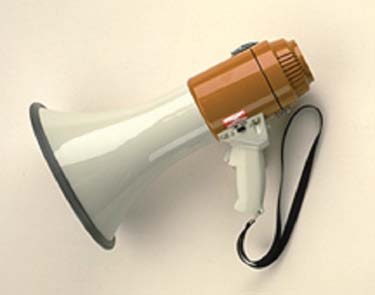
Nonlethal Capabilities Set and Employment Considerations
PORTABLE BULLHORN
5-26. The portable bullhorn (see Figure 5-23) provides squad leaders with the capability to project their voices above the noise and commotion created by
crowds and mobs. The megaphone has a built-in siren for alarm purposes that
allows the operator to use the device as an ordinary megaphone and siren
alarm during emergencies. The bullhorn is portable and easy to carry. The
acoustic range of the megaphone for a clear voice output is ¾ to 1 mile. The
power output of the megaphone is rated at 15 watts with a maximum rating of
20 watts. The dimensions of the megaphone are 14.5 inches with a 9-inch
diameter bell. It weighs 3.5 pounds without batteries. Battery requirements
for the megaphone are eight dry-cell size C batteries.
Figure 5-23. Portable Bullhorn
GROUND-MOUNTED BULLHORNS
5-27. Ground-mounted bullhorns (see Figure 5-24, page 5-14) are a critical communication enhancement device for conducting crowd control tactics. The
bullhorn can facilitate communication with the crowd in conjunction with
PSYOP support and assistance with the communication of commands to
troops engaged in the crowd control process. The power output of the ground-
mounted bullhorn is rated at 22 watts. The dimensions of the bullhorn are
13.75 by 9 by 14.75 inches, and it weighs 15 pounds.
INDIVIDUAL VOICE AMPLIFICATION SYSTEM (M7)
5-28. The M7 (see Figure 5-25, page 5-14) is a critical communication enhancement device for conducting crowd control tactics using RCAs while
wearing the M40 protective mask. The M7 is fitted to the M40 protective mask
to facilitate oral communication and increase the user's ability to
communicate using radios and other devices.
18 April 2005
FM 3-19.15
5-13
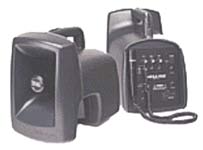
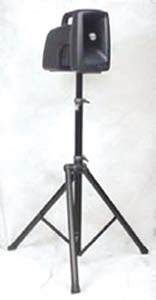
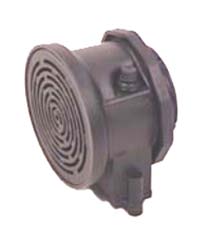
Nonlethal Capabilities Set and Employment Considerations
Figure 5-24. Ground-Mounted Bullhorns
Figure 5-25. Individual Voice Amplification System
INDIVIDUAL HIGH-INTENSITY SEARCHLIGHT WITH HOLSTER
5-29. The individual high-intensity searchlight (see Figure 5-26) is used primarily for illumination in crowd control operations at night. An individual can use it for general illumination of the operational area to pinpoint agitators and threats, reduce the ability of the rioters to see troop formations and
actions, enhance tactical deception and actions, and enhance tactical
deception techniques for units conducting crowd control operations.
HIGH-INTENSITY LIGHT
5-30. A high-intensity light (see Figure 5-27) is intended for use in low light or night conditions. A high-intensity light can project a beam that will enable the user to identify an individual person up to 1,900 yards away. It has an
adjustable beam spread of 1° to 15° and will run continuously at maximum
power for up to 45 minutes. The internal power supply requires 4 hours for a
full charge.
5-14
FM 3-19.15
18 April 2005
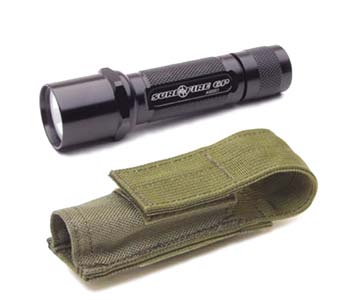
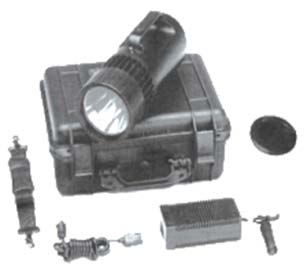
Nonlethal Capabilities Set and Employment Considerations
Figure 5-26. Individual High-Intensity Searchlight with Holster
Figure 5-27. High-Intensity Light
HIGH-INTENSITY LIGHT SYSTEM WITH 12-GAUGE SHOTGUN ATTACHMENT KIT
5-31. This 12-guage high-intensity light system (see Figure 5-28, page 5-16) is used to illuminate possible targets in crowd control situations where there is little or no light. It serves to blur or blind the aggressor’s ability to see. It mounts easily to the end of the 12-gauge shotgun barrel.
40-MILLIMETER CARRYING POUCH
5-32. The 40-millimeter carrying pouch is made from durable canvas
material, (see Figure 5-29, page 5-16) and can be easily affixed to load-bearing equipment (LBE) and/or a load-bearing vest (LBV) using Velcro straps. It is
capable of carrying up to six 40-millimeter rounds.
18 April 2005
FM 3-19.15
5-15


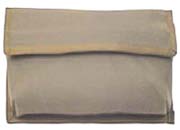
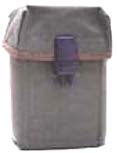
Nonlethal Capabilities Set and Employment Considerations
Figure 5-28. 12-Gauge High-Intensity Light System With 12-Gauge Shotgun
Attachment Kit
Figure 5-29. 40-Millimeter Carrying Pouch
12-GAUGE UTILITY POUCH
5-33. The 12-gauge utility pouch is made from durable canvas material (see
Figure 5-30). It can be easily affixed to an LBE and/or LBV using metal clasps.
The 12-gauge utility pouch is capable of carrying up to twenty-five 12-gauge
shotgun rounds.
Figure 5-30. 12-Gauge Utility Pouch
5-16
FM 3-19.15
18 April 2005
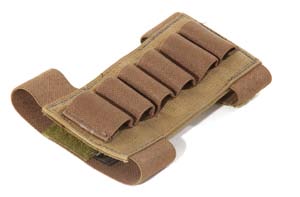

Nonlethal Capabilities Set and Employment Considerations
12-GAUGE BUTTSTOCK CUFF
5-34. The 12-gauge buttstock cuff (see Figure 5-31) firmly attaches to the shotgun by sliding over the stock. Elastic straps aid in preventing the
buttstock cuff from sliding or rolling. It holds up to seven 12-gauge cartridges, which give the soldier quick access to additional rounds.
Figure 5-31. 12-Gauge Buttstock Cuff
DIVERSIONARY AND/OR RUBBER BALL GRENADE POUCHES
5-35. The diversionary and/or rubber ball grenade pouch (see Figure 5-32) is an ammunition-carrying pouch made of durable canvas material. It is
partitioned in a manner to provide the soldier with a means of holding up to
six rubber ball grenades or six flash-bang grenades in separate compartments.
Figure 5-32. Diversionary and/or Rubber Ball Grenade Pouch
CALTROPS
5-36. The caltrop (see Figure 5-33, page 5-18) is a field-expedient area denial system. Securing approximately 50 caltrops to 550-type military cord allows a
soldier to quickly toss and recover the system. Caltrops are used to deny
vehicle and pedestrian movement in designated areas. The four prongs are
approximately 2 inches tall and will puncture tires or boots. A soldier can
easily employ the caltrop by scattering it in a designated area hidden by
camouflage.
18 April 2005
FM 3-19.15
5-17
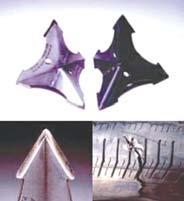

Nonlethal Capabilities Set and Employment Considerations
Figure 5-33. Caltrop
PORTABLE VEHICLE ARREST BARRIER
5-37. A portable vehicle arrest barrier (PVAB) (see Figure 5-34) is a lightweight, portable, manually-emplaced and recoverable-barrier
entrapment device that is used (on command) to create a barrier that will stop vehicles being driven by known or suspected hostile forces with minimal
damage to the vehicle and its occupants. Two individuals can easily emplace it in approximately 4 to 8 hours. It has the capability of stopping a light truck (up to 7,500 pounds) at speeds of up to 45 miles per hour with a stopping
distance of less than 200 feet. It is not to be used as a stand-alone system. The PVAB may be used at dismount points, checkpoints, and roadblocks to
prevent unauthorized access by wheeled vehicles into or out of areas.
Figure 5-34. PVAB
TRAINING DEVICES
5-38. Training devices that commanders can use to effectively prepare their
soldiers are included in the NLCS. Training devices allow soldiers to learn
and build confidence in the development of personal defensive skills. These
are critical pieces of equipment because they allow soldiers to train at almost full speed, which provides reinforcement of realistic motor skills. Training in this manner has proven to be more effective than just striking out at the air.
5-18
FM 3-19.15
18 April 2005


Nonlethal Capabilities Set and Employment Considerations
IMPACT TRAINING SUIT
5-39. Impact training suits (see Figure 5-35) are made of closed-cell shock-absorbent foam that allows soldiers to hone their riot baton skills through
realistic hand-to-hand training. Impact training suits absorb strikes inflicted by the current expandable and wooden riot batons. They provide protection for
the head, face, hands, and legs without significant degradation of the wearer’s mobility.
Figure 5-35. Impact Training Suits
TRAINING STRIKE BAGS
5-40. Training strike bags (see Figure 5-36) give the soldier a durable, yet absorbing surface to strike or kick for training. It also helps develops
proficiency in open-hand control and riot baton techniques.
Figure 5-36. Training Strike Bag
18 April 2005
FM 3-19.15
5-19
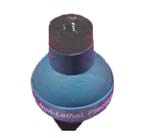
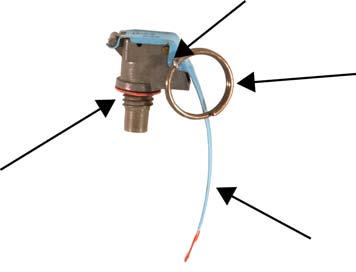
Nonlethal Capabilities Set and Employment Considerations
PRACTICE GRENADE BODY (GG05)
5-41. The GG05 is blue in color and is easily identified as a practice grenade (see Figure 5-37). It is designed to replicate the live GG04 rubber ball grenade.
It is made of durable rubber and can be hand-thrown or muzzle-launched from
the 12-gauge shotgun. It can be reloaded.
Figure 5-37. GG05
PRACTICE GRENADE FUSE
5-42. The practice grenade fuse (see Figure 5-38) is identified by its blue spoon and brown stripe. It easily screws into the body of the GG05. Once used, unscrew the practice grenade fuse from the body and reload it with a new
fuse.
Safety pin
Pull ring
Fuse thread
Safety lever
Figure 5-38. Practice Grenade Fuse
CORE CAPABILITIES
5-43. Core capabilities are those fundamental competencies that enable the
commander to achieve the desired operational outcome. In the case of NLW,
this includes providing a flexible means of response in order to protect friendly forces and/or influence the actions of potential adversaries and
noncombatants. With the availability of the NLCS (see Figure 5-39) these goals can be achieved without resorting to lethal force and in a manner that
will minimize collateral damage. The core capabilities associated with NL
effects fall into the following two major categories:
5-20
FM 3-19.15
18 April 2005
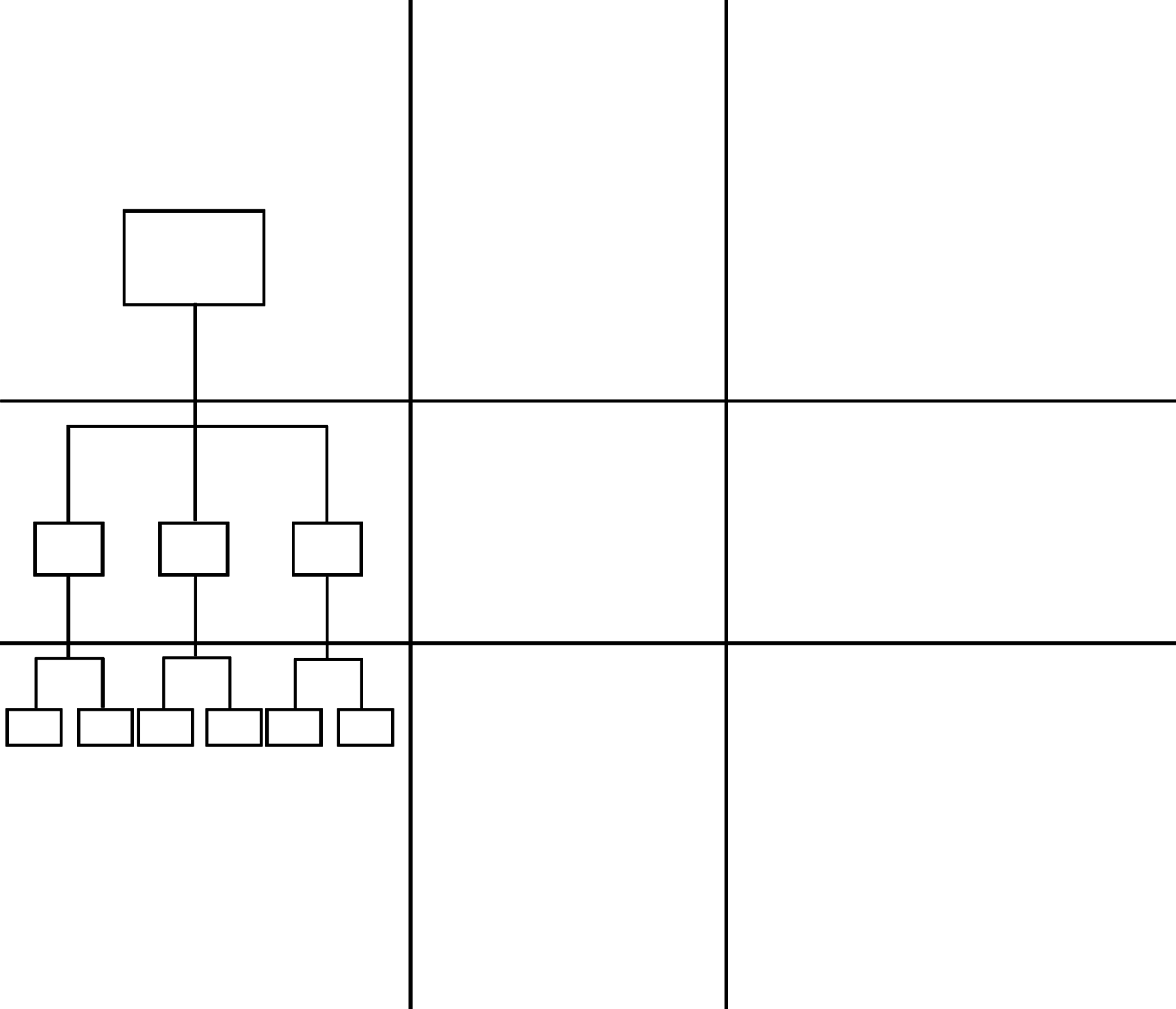
Nonlethal Capabilities Set and Employment Considerations
NOTE: There are nine platoon equivalents within a light infantry battalion.
PLT Organization
Personnel and Weapons
Nonlethal Weapons & Equipment
3 riot face shields
3 sets of shin guards
3 sets of full-body restraints
3 individual voice amplification systems
3 individual RCA dispensers with carriers
1 portable bullhorn
7 personnel
1 ground-mounted bullhorn
(5 M16/M4 and 2 M60/
1 high-intensity searchlight
M240)
1 set of caltrops
3 ballistic riot face shields
PLT
3 sets of ballistic shin guards
3 ballistic riot body shields
1 riot baton training suit
1 riot baton strike pad
3 riot face shields
3 sets of shin guards
3 riot body shields
3 expandable riot batons with carriers
3 personnel
9 sets of cinch-strap restraints
(3 M16/M4)
3 individual voice amplification systems
SQD
SQD
SQD
3 individual RCA dispensers with carriers
3 individual high-intensity search lights
with carriers (see Figure 5-26)
24 riot face shields
24 sets of shin guards
TM
TM TM
TM
TM
TM
100 sets of disposable flex-cuffs
24 individual voice amplification systems
24 personnel
24 individual RCA dispensers with carriers
(12 M16/M4 and 6 M16/
6 expandable riot batons with carriers
M4 with M203 6 SAW)
11 grenade pouches
12 forty-millimeter grenade pouches
6 twelve-gauge ammunition pouches
6 twelve-gauge bitstock ammunition
carriers
Figure 5-39. NLCS Distribution
z
Counterpersonnel. NL counterpersonnel capabilities enable the
application of military force with a reduced risk of fatalities or serious
casualties among noncombatants or, in some instances, among enemy
forces. There are several specific NL counterpersonnel capabilities to
be explored. These include the means to influence the behavior and
activities of a potentially hostile crowd, and the capability to bring a
mob engaged in a riot under control. While there are many similarities
in these two scenarios, each involves unique challenges, which may
require radically different solutions. For more information, see
FM 3-22.40.
z
Countermaterial. NL countermateriel capabilities enhance
operations by rendering equipment and facilities unusable without
complete destruction. An NL countermateriel capabilities enable the
18 April 2005
FM 3-19.15

































